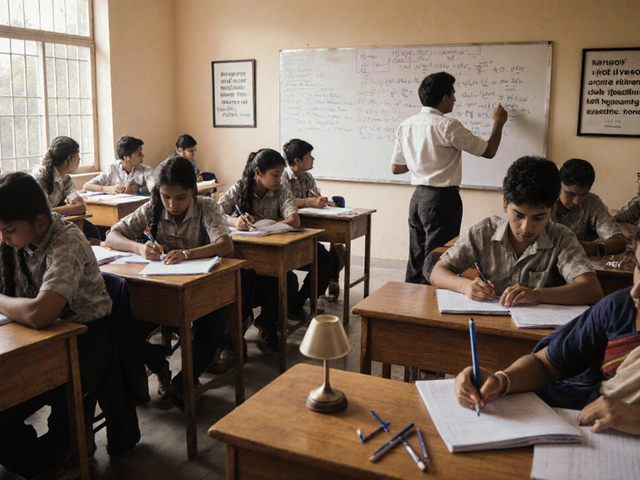Oct
8

- by Dhruv Ainsley
- 0 Comments
CBSE vs. International Curricula Comparison Tool
CBSE
Indian national board established in 1962, widely accepted in India and increasingly recognized abroad.
IB
International curriculum from Switzerland, known for holistic education and university preparation.
Cambridge
UK-based curriculum with global recognition, particularly strong in STEM and humanities.
| Criteria | CBSE | IB | Cambridge |
|---|---|---|---|
| Origin | India (1962) | Switzerland (1968) | United Kingdom (1858) |
| Grades Covered | Class 1–12 | DP (Grades 11–12) + PYP/MYP | IGCSE (Grades 9–10) + A-Levels (Grades 11–12) |
| International Recognition | Widely accepted in India; recognized by many US/UK universities | Globally recognized; preferred for elite universities | Accepted worldwide; strong in UK, Australia, Singapore |
| Tuition Cost (USD/year) | $3,000–$8,000 | $12,000–$25,000 | $8,000–$18,000 |
| Academic Focus | STEM subjects, foundational learning | Research, critical thinking, creativity | Academic rigor, global perspective |
| Extracurricular Emphasis | Minimal structured activities | Strong CAS component | Moderate focus |
- Unified syllabus across India and abroad
- Strong foundation in math and science
- Affordable tuition fees
- Wide network of affiliated schools
- Recognized by Indian universities
- Less emphasis on creative and holistic development
- May not be ideal for liberal arts pathways
- High-stakes board exams can be stressful
- Limited recognition outside STEM fields
When you hear the acronym CBSE, you probably think of Indian students in uniforms marching to exams. But the question that keeps popping up online is: Is CBSE Indian or International? The short answer is both - it’s an Indian‑run board that has expanded its reach far beyond the subcontinent. In this article we’ll unpack what CBSE really is, trace its origins, map its global footprint, compare it with other popular curricula, and give you practical tips if you’re considering CBSE for studying abroad.
What Exactly Is CBSE?
CBSE is a national-level education board in India that conducts the secondary (Class 10) and senior secondary (Class 12) examinations for public and private schools. It operates under the Indian Ministry of Education, which sets the overall policy for India's school system.
CBSE was established in 1962, taking over from the older University Board of Secondary Education. Its primary mission is to provide a uniform curriculum across the country, reduce regional disparities, and ensure students are ready for national competitive exams like the JEE and NEET.
How CBSE Became International
Despite its Indian roots, CBSE now runs schools in more than 30 countries, ranging from the United Arab Emirates to Singapore, and even a handful in the United Kingdom and the United States. These overseas CBSE schools are often called International CBSE Schools. They follow the same syllabus, use the same textbooks published by the National Council of Educational Research and Training (NCERT), and sit for the same board exams as their Indian counterparts.
Why do they exist? Two main reasons:
- Indian diaspora demand: Millions of Indian families living abroad want their children to stay connected to the Indian curriculum, especially if they plan to return to India for higher studies.
- Cost‑effectiveness: CBSE schools generally charge lower fees compared to Western international curricula, making them attractive to expatriate families on a budget.

CBSE vs. Other International Curricula
When parents search for "best curriculum abroad," three names dominate the conversation: CBSE, the International Baccalaureate (IB), and Cambridge Assessment International Education (Cambridge). Below is a quick side‑by‑side comparison.
| Board | Origin | Grades Covered | International Recognition | Typical Tuition (USD/yr) |
|---|---|---|---|---|
| CBSE | India (1962) | Class 1‑12 | Widely accepted in Indian universities; recognized by many US/UK universities for equivalency | 3,000‑8,000 |
| IB | Switzerland (1968) | DP (Grades 11‑12) + PYP/MYP (earlier years) | Globally recognized; often preferred for elite universities | 12,000‑25,000 |
| Cambridge | UK (1858) | IGCSE (Grades 9‑10) + A‑Levels (Grades 11‑12) | Accepted worldwide; strong foothold in UK, Australia, Singapore | 8,000‑18,000 |
The table shows that CBSE’s international credibility isn’t on par with IB’s university‑level prestige, but it still offers solid academic grounding, especially for students eyeing Indian higher education or engineering streams.
How Universities Abroad View CBSE
Most overseas universities use credential evaluation services like WES (World Education Services) or NARIC to translate CBSE scores into their local grading scales. For example, a 90% in CBSE Class 12 is typically equated to a First Class Honours in the UK or a GPA of about 3.7 in the US. However, there are a few nuances:
- Science streams: Indian engineering colleges prioritize high marks in Physics, Chemistry, and Mathematics, which aligns well with US STEM admissions criteria.
- Humanities: Some liberal arts programs prefer IB because of its Theory of Knowledge component, which CBSE lacks.
- English proficiency: CBSE doesn’t mandate a separate IELTS/TOEFL score, so students may need to take those exams independently.
Bottom line: CBSE graduates can get into top universities abroad, but they often have to supplement their applications with standardized test scores and strong personal statements.
Pros and Cons of Choosing CBSE for an International Student
Every curriculum has trade‑offs. Here’s a quick rundown to help you decide if CBSE fits your global education plan.
Pros
- Unified syllabus: Same textbooks and exam pattern worldwide, making transitions between Indian and overseas CBSE schools seamless.
- Focus on fundamentals: Maths and Science concepts are taught in depth, which benefits engineering and medical aspirants.
- Cost‑effective: Tuition fees are often lower than IB or Cambridge schools.
- Wide network: Over 21,000 schools in India and many abroad, so finding a CBSE‑affiliated school is relatively easy.
Cons
- Limited extracurricular emphasis: Compared with IB’s creativity, activity, service (CAS) requirement, CBSE offers fewer structured out‑of‑class opportunities.
- Less recognition for liberal arts: Universities focused on humanities sometimes view CBSE as a “science‑heavy” board.
- Single‑exam pressure: Board results hinge on two high‑stakes exams (Class 10 and 12), which can be stressful.

How to Enroll in a CBSE School Abroad
If you’ve decided CBSE is the right fit, follow these steps to secure a spot:
- Identify the nearest International CBSE School. Use the official CBSE website’s ‘School Directory’ feature, which lists verified schools by country.
- Check admission criteria - most schools require previous years’ report cards, a transfer certificate, and proof of residence.
- Arrange for the NCERT textbooks to be shipped or purchased locally. Many schools provide a “starter kit” for new entrants.
- Register for the Board’s online portal (the CBSE Academic Services) to access sample papers, grading schemes, and the exam timetable.
- Prepare for the board exams by joining a coaching centre or using free resources offered by the Indian Ministry of Education’s open‑education portal.
Remember that CBSE’s academic calendar aligns with the Indian fiscal year (April‑March), so a school in the US may adjust term dates to fit local holidays while still adhering to board deadlines.
Key Takeaways
- CBSE is fundamentally an Indian national board, established in 1962 under the Indian Ministry of Education.
- It has grown internationally, with schools in over 30 countries serving the Indian diaspora and budget‑conscious families.
- Universities abroad accept CBSE qualifications, though students often need additional language tests and extracurricular evidence.
- Compared with IB and Cambridge, CBSE is more affordable and academically rigorous in science, but less focused on holistic development.
- Enrolling overseas involves locating a certified CBSE school, meeting its admission criteria, and syncing with the Indian exam schedule.
Frequently Asked Questions
Is CBSE considered an international board?
CBSE is an Indian national board, but it operates schools abroad and its certificates are accepted worldwide, making it functionally international.
How does CBSE compare with the International Baccalaureate?
IB places stronger emphasis on research, critical thinking, and extracurriculars (CAS), while CBSE focuses more on core academic subjects, especially STEM. IB is generally pricier and is preferred for liberal arts pathways.
Can I take CBSE exams while living in the United States?
Yes. Many American cities have accredited CBSE schools. You’ll follow the same exam timetable as India and may need to travel to a regional test centre for the board exams.
Do universities in the UK recognize CBSE scores?
UK universities accept CBSE qualifications via credential evaluation agencies. A high CBSE percentage is usually equivalent to a UK ‘A‑Level’ grade, but you may still need to meet specific subject requirements.
What textbooks does CBSE use?
CBSE prescribes textbooks published by the National Council of Educational Research and Training (NCERT). These are the same across all CBSE schools globally.
Is there a CBSE curriculum for primary grades?
Yes. CBSE offers a structured syllabus for Class 1‑8, focusing on foundational literacy, numeracy, and basic sciences. The curriculum aligns with the secondary syllabus to ensure a smooth transition.





